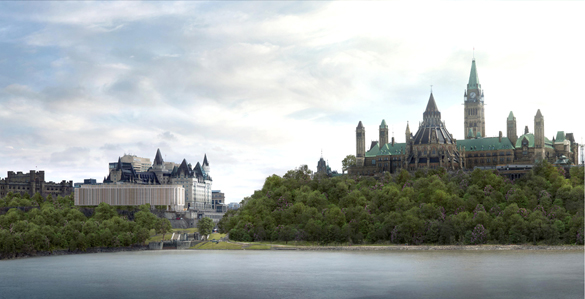Back at City Hall

I found myself back at City Hall on Monday. The Built Heritage Sub-Committee met to consider City staff’s recommendation that the latest design proposal for the extension of the Château Laurier be accepted. I was one of several speakers who signed up to argue against the recommendation (apart from the architect and his associates, there were no speakers in favour). Here is a fleshed-out version of my remarks, drawn from my notes:
The Château Laurier and its proposed addition are incompatible. I offer that not as an opinion, but as a simple observation of fact. The Château – and its ensemble of Parliament, Canal, escarpment and river – was designed according to 18th and 19th century theories of the Picturesque and the Sublime. The addition is a Modernist box designed according to 20th century theories of functionalism and minimalism.
The 20th century idea of the Modernist box evolved explicitly to repudiate and discredit the earlier theories, not to harmonize with them. So it should surprise no one that they are incompatible – they are meant to be, it is in their DNA. What’s surprising is that, a year and a half later, we’re still discussing whether or not it’s a good idea to add a modernist box to the Château Laurier.
The reason, we’re still discussing it is actually quite simple. Throughout the process, the question has been framed as a choice between two options only: the addition can only be either an exact imitation of the existing building, or stand in radical, even violent contrast to it. That is the extent of what has been offered: black or white, imitate or violate.
One of these – imitation – was immediately deemed unacceptable. That’s a debatable claim, but we’ve never had that debate either. But imitation was ruled out, so we’re left with violation. Consequently, we’ve just been going in ever tightening circles around the fundamentally flawed idea that a Modernist box is the only alternative to blatant imitation.
But if there’s one thing that the history of architecture shows us, it’s that really beautiful, successful solutions to such problems often lie in the fertile middle, in a creative synthesis of old and new. There are examples of this dating back at least a thousand years. Some examples are: the Gothic choir added to the Romanesque nave of Vézelay, Brunelleschi’s Renaissance dome on the Gothic cathedral at Florence and Venturi and Scott Brown’s Postmodern addition to the National Gallery in London.
Moreover, Ottawa is full of examples of such creative syntheses. The 1970s addition to the Bank of Canada embraces the fundamental values and qualities (not features) of Classicism, to harmonize with the historic building. The Museum of Nature’s glass tower takes up the idea of a tower that was intended all along, and completes it in a modern language. The glass additions to the National Arts Centre respect and reiterate the massing and geometry of the concrete building. All of these examples work because they start by analyzing the qualities of the buildings to which they add, and make connection with them a fundamental design principle.
For whatever reason, this kind of creative synthesis has not been offered in any of the proposed designs for the Château Laurier. The premise of the box remained sacrosanct, while a number of ‘tweaks’ were added in the hope of distracting from the fundamental flaws.
I want to make one other point – a plea, really – about process. In an editorial last weekend, the Citizen asked the question (I’m paraphrasing), if the applicant ticks all the boxes and it’s still rejected, why have a process at all?
It’s a reasonable question. But if the Built Heritage Sub-Committee (and Planning Committee, and City Council) do what I and others are urging you to do – reject the proposal – you are not undermining the process – because you are part of the process. In fact, you are arguably the most important part. You are the manual override; the driver in what could otherwise become a driverless car of process. We count on you to see the forest as well as the trees. You are our last line of defence against bad outcomes growing out of ticked boxes. We need you to embrace that responsibility and authority, and use it for the public good.
When making your recommendation, please think about why we need you. And perhaps also remember that whatever gets built will be, for generations to come, your legacy.
It was a marathon meeting, with an unusual outcome, which I will discuss in my next blog.
Peter Coffman
peter.coffman@carleton.ca